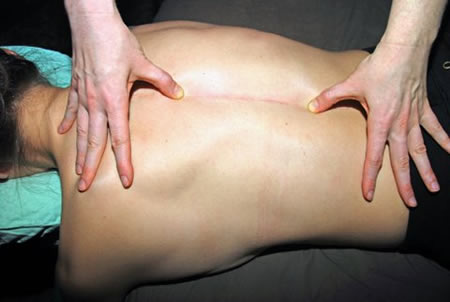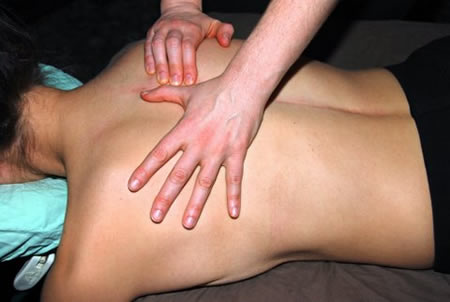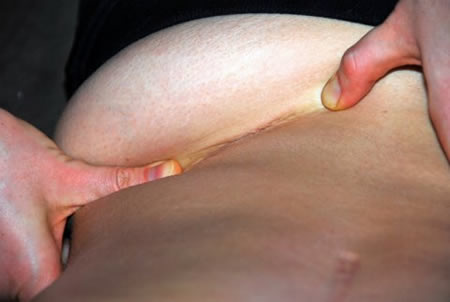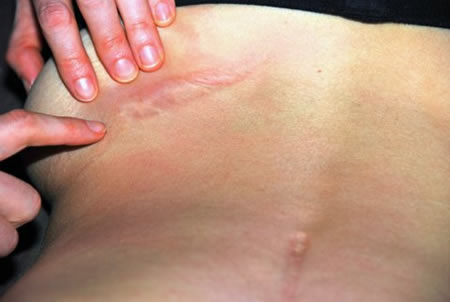Positive Health Online
Your Country

Add as bookmark
The Importance of Scar Tissue Release Therapy
listed in bodywork, originally published in issue 169 - April 2010
Scar tissue therapy is generally overlooked by health professionals because the extent of physiological effects scars can have on the body have never really been acknowledged. As massage therapists, we know that the slightest restriction in the elaborate matrix of fascia can have major repercussions from one end of the body to the other.
The pictures are of a 30 year old woman who had her spine rodded at age 14 due to Scoliosis.
The first two and the last picture are of the author working the hypertrophic scar on her back.
The ones in the middle are of the widespread scar left after the surgeon went in to her hip
to harvest marrow to help cement in the rods.
The first two and the last picture are of the author working the hypertrophic scar on her back.
The ones in the middle are of the widespread scar left after the surgeon went in to her hip
to harvest marrow to help cement in the rods.

A simple scar from a childhood accident to major surgery can have a lifelong effect both physically and mentally for your client. Scar tissue has the potential to spread in any direction including internally throughout the body. It can also restrict movement or function anywhere in the body from a joint to an organ.

Scar tissue release therapy is extraordinarily simple to learn, easy to apply and yields powerful results that can prevent a lifetime of compensation, complications and pain. I have been a licensed massage therapist for more than 12 years and in all that time, a reoccurring theme seems to have prevailed. The presence of scar tissue can have a lifelong physiological effect on the body – a fact that seems to have eluded traditional health care professionals. This realization, combined with my clinical experience, education, teaching and research, has led to developing methods that improve upon existing fascial techniques for scar tissue release.
During the course of my career I've treated many patients whose problems could be traced back to a scar they had forgotten they even had. Almost everyone has a scar. While not every scar presents a problem, often they can. This is due to the fact that the body is one large, three-dimensional piece of fascia that envelops us like an intricate spider web. Any kink, pull or restriction in one area affects the whole matrix.
Scar Tissue and Adhesions
Scar tissue and adhesions are the result of our body's natural healing process which occurs both internally and externally. The process, if working correctly, is supposed to eliminate the scars and adhesions once the wound is healed. In some cases, a person's body does not break down the scar tissue. The adhered tissue continues to spread which can trigger a cascading effect of compensations throughout the body.
Scars are areas of fibrous tissue that have replaced normal skin, or other tissue, after injury. A scar results from the biologic process of wound repair (protective, useful barrier) in the skin and other tissues of the body. Scar tissue is never as functional as the original tissue it has replaced. With the exception of very minor lesions, every wound (both internal and external) results in some degree of scarring.

Adhesions are bands of scar tissue that anchor and support the wound. It binds together all tissue with which it comes into contact. Adhesions may be thought of as internal scar tissue. Although adhesions can occur anywhere, the most common locations are within the stomach, pelvis and heart. (For a comprehensive list of specific types of scar tissue and adhesions go to www.brookseminars.com/resources.)
Cases of Scar Tissue Treatment
Scar tissue release therapy is extraordinarily simple to learn, easy to apply and yields powerful results that can prevent a lifetime of compensation, complications and pain. The therapy is a series of fascial techniques that release and realign the restrictive tissue from the starting point (visible scar) to the end point (where the line of frozen fascia stops). This release system differs from traditional methods because it approaches the multi-faceted matrix of fascia three dimensionally.I have used this therapy with success for clients who range in age (from children to seniors) and who have experienced a broad scope of problems. In many cases, the results have been achieved within one to three sessions. Below are the stories of three clients who have experienced dramatic results (client names have been changed to protect their identities).

Another client for general relaxation massage referred 'Laura' to me. Prior to starting our first session she forewarned me (out of being embarrassed) that her leg was 'scary' looking, due to vein removal surgery she'd had several years prior. I've seen and helped many clients with scar tissue resulting from vein removal surgery, but was stunned at hers. Starting about two inches above her knee all the way down to the middle of the foreleg was a scar every inch and a half – with skin puffing up in between. It looked as though she had been bitten by a shark. In addition to the physical scarring, she experienced pain in her knee and down her leg (which made it difficult to keep up with her four boys). As you would imagine, these scars not only affected her physically, but emotionally as well. She was very self-conscious of their appearance, so uneasy that she had not worn shorts since the surgery. She was frustrated that she couldn't keep up with her mother's walking pace while out shopping. And she was angry because her doctor told her nothing could be done, "it just healed that way." But after just one scar treatment session Laura experienced relief physically. By the end of three sessions the swelling was gone, the scars were reduced and Laura was thrilled. Laura's scars have faded by 85 percent. She now wears shorts and was able to actually go skiing with the boys for the first time in four years!
'Debbie', 35, came to me several years ago for help with what she thought was carpal tunnel syndrome. After observing a large scar on Debbie's wrist I inquired as to its origin. When she was nine years old she had put her hand through a window, chasing her brother. After working on her hand for two sessions, scars from the glass cuts were reduced visibly by about 80 percent, she obtained range of motion back in her hand/wrist and the numbness was gone.

Another regular massage client one day inquired about my services for his 10-year-old son 'Bobby'. Bobby, who is very active in sports, was born with a clubfoot and was experiencing a lot of pain in the Achilles tendon of his good leg. After three surgeries his foot was locked in an inverted position causing him to walk on the outside edge of the foot. He was also scheduled for a fourth in a series of seven surgeries. After a thorough evaluation it was clear that it was not the deformity of Bobby's club foot that was holding his foot in this position – but the scar tissue and adhesions from the past surgeries which were wrapped around the ankle into the arch of the foot and up the back of the Achilles tendon. Due to the inversion of the foot, Bobby was using his hip flexors to move his leg forward. After working on Bobby's good leg, I asked his parents if it would be all right if I worked on the other foot. Much to the parent's shock, after the first session of treatment, Bobby's foot released about 90 degrees. Upon seeing her son stand with his foot almost flat on the ground Bobby's mom said half in shock and half in anger, "Why didn't the doctors tell us to work on the scars? We would have done it everyday!" I continued to work with Bobby for almost two years. Along with continued work on removing the extensive scar tissue, he needed stretching and strengthening sessions to retrain the muscles in the atrophied leg and throughout his hip. While his foot will always be stunted from his deformity, he never did have that fourth surgery.
It is my hope that with modern science starting to recognize the importance of fascia and the effects of scar tissue on the body, that scar tissue release will be brought to the forefront of therapy. Massage therapists can make significant and long-lasting changes in the health and well-being of their clients by incorporating scar tissue release therapy into their treatments. It is my experience that this therapy can play a major supportive and therapeutic role in helping anyone living with the physical, emotional and mental effects of scar tissue and adhesion restrictions.
Comments:
-
No Article Comments available

